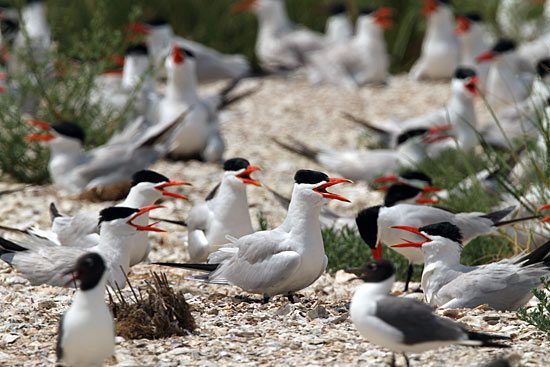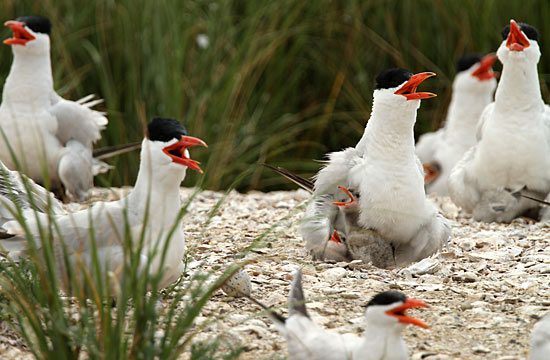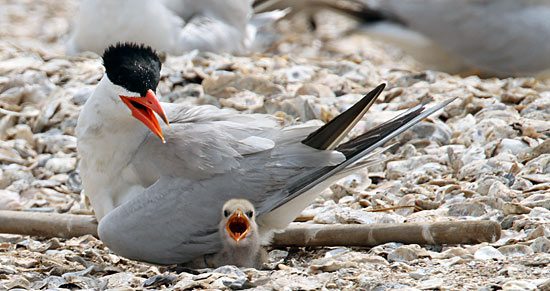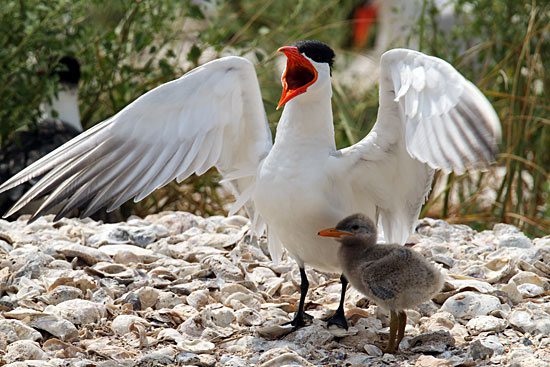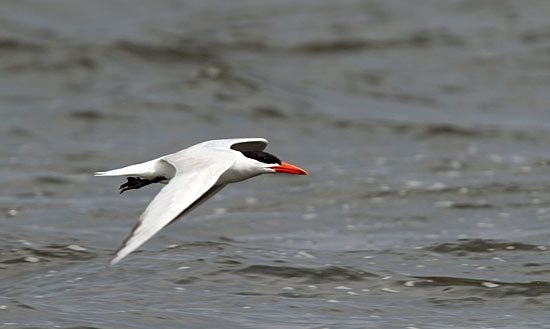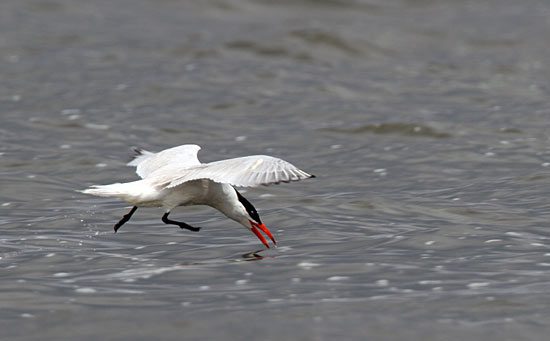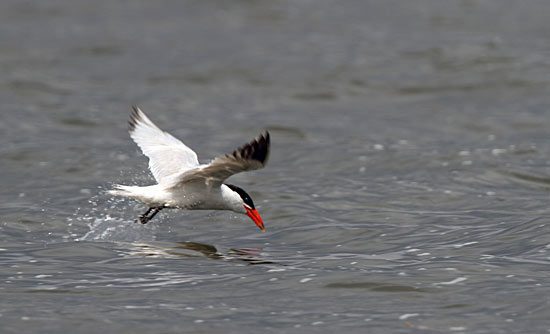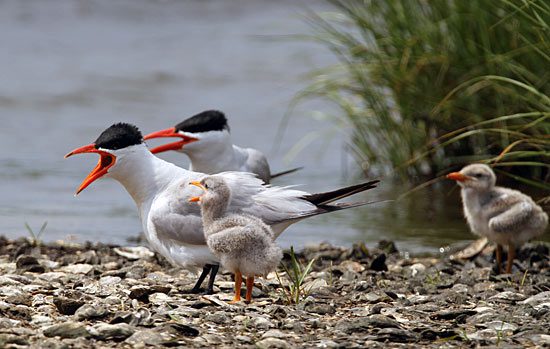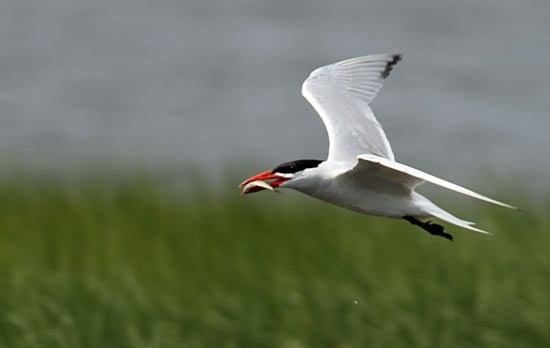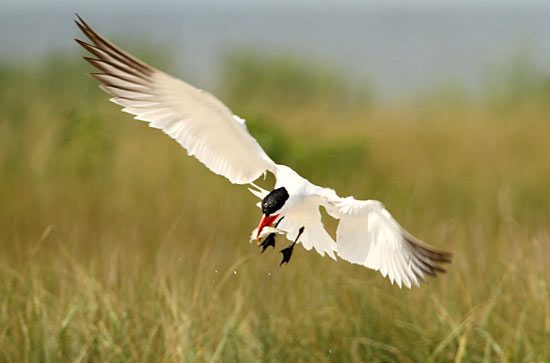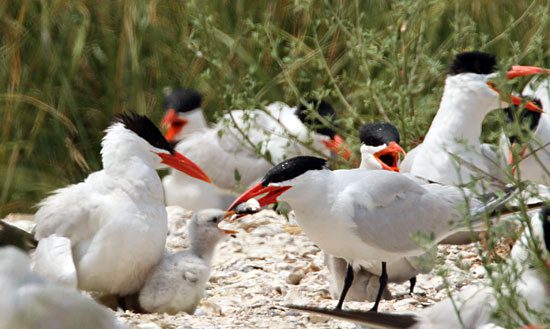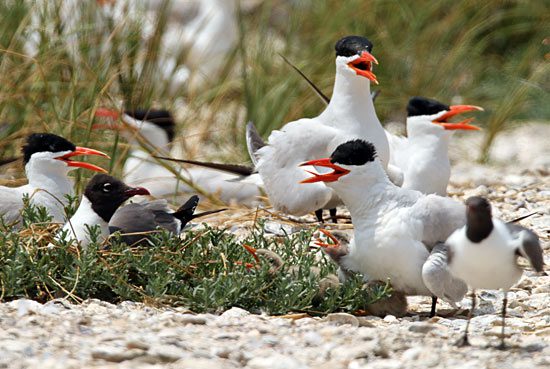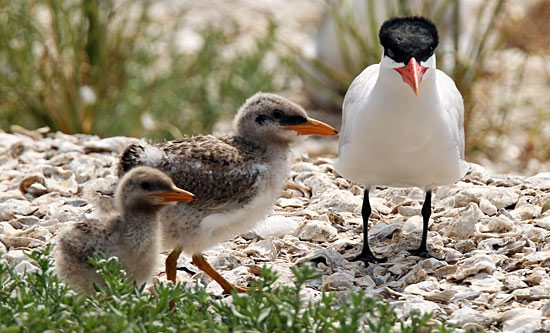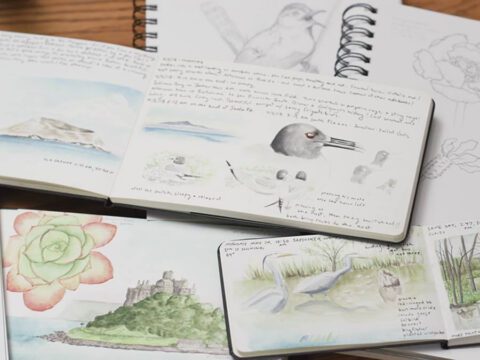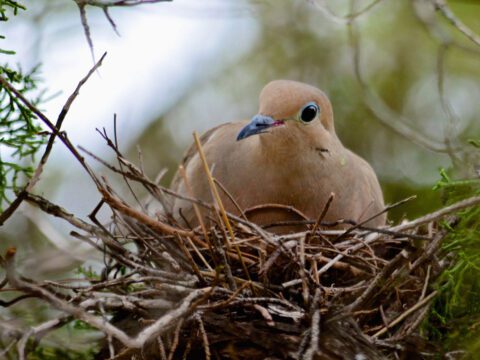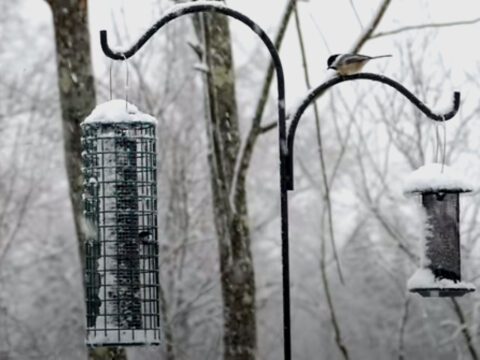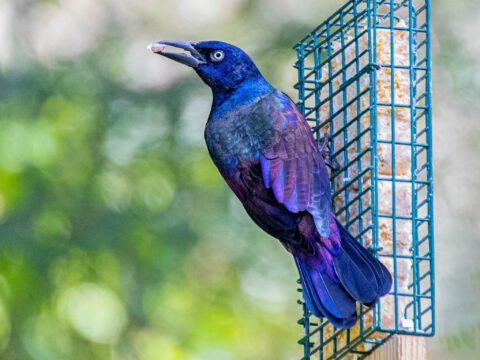Louisiana report: Caring for Caspian Tern chicks (slideshow)
Text by Hugh Powell. Images by Benjamin Clock.
June 24, 2010
Caspian Terns flash brilliant red bills at a colony near the Iron Banks 
Most pairs had chicks—some small and still being brooded by their parents 
Brooding parents shelter their chicks from the withering Louisiana sun 
This chick is huddled against the shady side of its protective parent 
We watched Caspian Terns fly out from the colony, low over the water 
Many were out for a quick drink (terns have a salt gland that allows them to drink seawater) 
Terns leaving the colony typically dab their feet on the water, as if washing sand from their feet 
Older chicks stood on their own, with parents watching over them 
Caspian Terns are large birds, and they brought large fish back to their chicks 

Then offer their fish to the waiting chick 
Laughing Gulls (at left and right) seem harmless enough, but they will attack unguarded chicks 
In a few more days, these larger chicks will begin to band together in groups called creches
While we were out at Iron Banks (after rescuing a frigatebird), we ran across a colony of a couple of hundred Caspian Terns on a skinny, boomerang-shaped island. Though we had seen no oil in this part of the Delta, just watching the birds coming and going brought home how susceptible they could be.
These are the largest terns in the world—about the size of a Laughing Gull—with gleaming black caps that hide their eyes and end abruptly in a squared-off crest. Their bills are brilliant red-orange, much thicker at the base than the tip; they look capable of doing surgery. With so many terns sitting on the ground, the bright bills pointing this way and that formed an abstract pattern against the tan shells and green plants.
Ben and Larry were filming the birds from a safe distance upwind. Although Caspian Terns are aggressive birds, they’re also wary. We were careful not to frighten them into flying up—the Laughing Gulls at the edge of the colony wouldn’t waste much time going after the unprotected chicks.
Birds on their way out to fish typically headed into the wind—straight at us—as they took off, giving hoarse shrieks before wheeling around toward the water. Just as many birds were returning, carrying plump fish hanging crossways in their bills.
One returning bird landed by fluttering straight down into a helicopter landing. Males and females share almost equally in caring for chicks, and they’re considerate; they often return with a fish for their mate before changing places at the nest. As this bird landed it pattered over to the nest on its black feet.
The chick was hiding under one parent, and the returning adult offered the fish with a series of careful bobs of its head. When the chick didn’t emerge to take it, the adult walked around and peered under its mate’s tail, like a human father checking the garage for one of his missing kids. Soon a Laughing Gull came gliding in low to make a play for the fish. The tern was too quick; it took off and then flew out over the water in a wide semicircle.
I was delighted to see the bird neatly dip the fish into the water and then return, a behavior I had read about. The adults re-wet their catches if they hold them too long to make them easier for the chicks to swallow. (Caspian Terns can be unreasonable parents in other ways: they occasionally catch too-large fish, but force-feed them to their chicks anyway. The chicks either spit the fish back out or, occasionally, choke on them.)
The sun was getting high, and the nearly tropical climate of southern Louisiana was in full gear. All the terns were panting—that’s what the birds with open beaks are doing in the pictures above, not calling. The adults stood with their backs to the sun and drooped their wings around their young chicks to keep them cool. Even the solitary Laughing Gulls were pressing themselves into the shady side of whatever low vegetation grew nearby.
I started seeing birds leave the colony and make the same semicircular flight I had seen earlier, though they carried no fish. The first thing they did was to dab their feet into the water, as if washing the sand off their toes. Then they did a curious, slow-motion belly flop. Flying low over the water, each raised its wings, stalled partially, and then splashed its breast and belly into the water before flying on. It was both clumsy and deliberate.
Back in the air, the bird typically flew immediately back to the nest and resumed brooding its chicks. It seemed to be intentionally wetting its breast feathers to help the chicks stay cool.
From pattering their feet across the water for a rinse, to drinking on the wing, to wetting their breast feathers, to plunging headlong into the sea for food, everything these birds do, all summer long, exposes them to danger from surface oil. Should adults wind up with oil on them, they’re at risk of passing it on to their chicks either by brooding them or by feeding them. Studies of several seabird species have found that even very small amounts of oil exposure cause chicks to grow more slowly, to develop deformities, or to die. And in this withering heat, even a slight matting of the feathers could compromise a bird’s ability to keep cool.
We didn’t see any oiled Caspian Terns that day—we’ve been mainly working in large stretches of saltmarsh that have fortunately stayed clean so far. But it’s these so-called sublethal effects of oil that concern scientists. Their toll is harder to detect than severe oilings that leave birds helpless on beaches, but long-term studies after the 1989 Exxon Valdez spill suggests they have an overall larger effect on seabird populations. We need to vigilantly monitor seabird colonies, to find out whether they are finding oil even when the oil has yet to find them.

All About Birds
is a free resource
Available for everyone,
funded by donors like you
American Kestrel by Blair Dudeck / Macaulay Library
